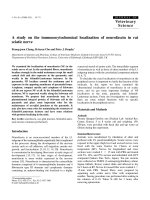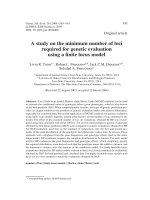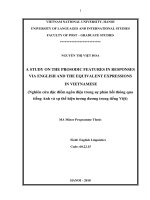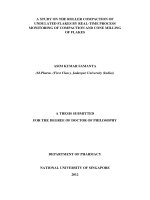A study on the main features of short jokes and implications for teaching speaking to students of grade 12 at ngoc tao upper secondary school
Bạn đang xem bản rút gọn của tài liệu. Xem và tải ngay bản đầy đủ của tài liệu tại đây (396.81 KB, 6 trang )
Vietnam national university, HANOI
UNIVERSITY OF LANGUAGES AND INTERNATIONAL STUDIES
FACULTY OF POST-GRADUATE STUDIES
PHAN THỊ AN
A STUDY ON THE MAIN FEATURES OF SHORT JOKES
AND IMPLICATIONS FOR TEACHING SPEAKING TO
STUDENTS OF GRADE 12 AT NGOC TAO UPPER
SECONDARY SCHOOL
NGHIÊN CỨU VỀ ĐẶC ĐIỂM CHÍNH CỦA THỂ LOẠI TRUYỆN CƯỜI NGẮN
VÀ NHỮNG ỨNG DỤNG TRONG VIỆC DẠY NÓI CHO HỌC SINH TRƯỜNG
THPT NGỌC TẢO- HÀ NỘI
M.A. MINOR THESIS
Major: Methodology
Code: 60.14.10
HANOI – 2010
Vietnam national university, HANOI
UNIVERSITY OF LANGUAGES AND INTERNATIONAL STUDIES
FACULTY OF POST-GRADUATE STUDIES
PHAN THỊ AN
A STUDY ON THE MAIN FEATURES OF SHORT JOKES
AND IMPLICATIONS FOR TEACHING SPEAKING TO
STUDENTS OF GRADE 12 AT NGOC TAO UPPER
SECONDARY SCHOOL
NGHIÊN CỨU VỀ ĐẶC ĐIỂM CHÍNH CỦA THỂ LOẠI TRUYỆN CƯỜI NGẮN
VÀ NHỮNG ỨNG DỤNG TRONG VIỆC DẠY NÓI CHO HỌC SINH TRƯỜNG
THPT NGỌC TẢO- HÀ NỘI
M.A. MINOR THESIS
Major: Methodology
Code: 60.14.10
Supervisor: Prof. Dr. Nguyễn Xuân Thơm
HANOI - 2010
4
TABLE OF CONTENTS
STATEMENT OF AUTHORSHIP .......................................................................................... i
ACKNOWLEDGEMENTS .................................................................................................... ii
ABSTRACT ............................................................................................................................ iii
TABLE OF CONTENTS ........................................................................................................ iv
INTRODUCTION .................................................................................................................... 1
1. Significance of the study......................................................................................................... 1
2. Aims of the study ................................................................................................................... 2
3. Scope of the study .................................................................................................................. 2
4. Methods of the study ............................................................................................................. 3
5. Design of the study ................................................................................................................. 3
PART II: DEVELOPMENT
CHAPTER I: THEORETICAL BACKGROUND ................................................................. 4
I.1. Humour ................................................................................................................................ 4
I.2. The distinction between humour and witticisms ................................................................... 5
I.3. The language of humour ....................................................................................................... 5
I.3.1. The Incongruity theory ...................................................................................................... 6
I.3.1.1. Structural ambiguity ....................................................................................................... 6
I.3.1.2. Unconventional use of language ..................................................................................... 7
I.3.2. The Superiority theory ....................................................................................................... 7
I.3.3. The Release/Relief theory.................................................................................................. 8
I.4. Humour competence
I.4.1. Joke competence and humour competence ......................................................................... 9
I.4.2. Social factors of humour competence .............................................................................. 10
I.5. English language and the English sense of humour ............................................................. 12
I.6. Jokes and the use of jokes in teaching English as a foreign language .................................. 13
I.7. Ambiguity in language and humour studies ........................................................................ 15
CHAPTER TWO: MAJOR LINGUISTIC FEATURES OF ENGLISH SHORT
JOKES
II.1. Ambiguity in English short jokes ...................................................................................... 19
5
19
II.1.1. Focus of ambiguity......................................................................................................... 19
II.1.2. Proportion in the focus of ambiguity .............................................................................. 23
II.2. Further analysis of ambiguity exploited in English puns .................................................... 24
II.2.1. The ambiguity devices ................................................................................................... 24
II.2.1.1. Lexical ambiguity ....................................................................................................... 24
II.2.1.2. Syntactic ambiguity ..................................................................................................... 25
II.2.2. Proportion of ambiguity devices exploited in English humour ........................................ 28
CHAPTER THREE: LINGUISTIC AND CULTURAL DIFFICULTIES IN
APPRECIATING SHORT JOKES OF NGOC TAO STUDENTS. SUGGESTIONS
ON IMPLYING TEACHING SHORT JOKES IN SPEAKING CLASSES.
III.1. Ngoc Tao Upper Secondary School’s Profile ................................................................... 30
III.2. Linguistic difficulties in appreciating jokes of students at Ngoc Tao High School.
III.2.1. Attitude of the learners to the humour in speaking lessons ............................................ 31
III.2.2. Difficulties in appreciating English short jokes of students in Ngoc Tao High
School ...................................................................................................................................... 32
III.3. Cultural difficulties in appreciating jokes of students at Ngoc Tao High School. .............. 35
III.4. Suggestions to use short jokes in teaching speaking skill to students of grade 12 in
Ngoc Tao Upper Secondary school........................................................................................... 35
III.5. Finding ............................................................................................................................ 37
PART III: CONCLUSION .................................................................................................... 39
REFERENCES ....................................................................................................................... 41
APPENDICE............................................................................................................................ 44
3
ABSTRACT
English jokes tend to cause problems to language learners because of their linguistic,
cultural and socio features. In this study, the author examined the corpus of 100 simple
jokes given in the book “America one and two liners” and some searched from websites to
investigate the linguistic features of English short jokes. The study is based on theories of
humour. From the findings of linguistic features of short jokes, the author suggests some
activities for teaching speaking skill at a high school with the aim to use jokes as a useful
material to motivate students.
Thank you for evaluating AnyBizSoft PDF
Merger! To remove this page, please
register your program!
Go to Purchase Now>>
AnyBizSoft
PDF Merger
Merge multiple PDF files into one
Select page range of PDF to merge
Select specific page(s) to merge
Extract page(s) from different PDF
files and merge into one









